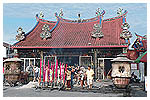 |
 |
 |
 |
 |
 |
 |
 |
 |
The
Penang Global Ethic Project
|
|
Click
here for
Introduction |
Click here
for Location
Map |
|
|
•
World
Religions Walk World
Religions Walk, Penang For
guided tours, contact:
|
This is the
starting point of the World Religions Walk. The Penang Museum offers
a good introduction to the culture and social history of Penang.
Open daily, 9am-6pm. Closed on Fridays. |
The oldest Catholic church in Penang, formed in 1786 by the Eurasians of southern Thailand and Kedah. The church building dates from 1860. The church was elevated to the Cathedral of the Diocese of Penang in 1955. |
The oldest Anglican Church in Southeast Asia. The building dates from 1818 and was designed by Captain Robert Smith of Madras Engineers, who painted the famous early views of Penang. The Anglicans follow the traditions developed by the Church of England. |
This private
shrine dedicated to the Hindu goddess Durga is managed by a Gujarati
family and caters to the North Indian Hindu community. Housed in
a |
The Kuan Yin Temple is a Chinese temple dedicated to the Goddess of Mercy, an incarnation of the Boddhisatva Avaloekiteshvera. On the 1st and 15th of each lunar month, devotees observe a vegetarian diet and offer joss-sticks at the temple. The temple hosts Chinese opera and puppet shows during the three annual feast days on the 19th day of the second, sixth and ninth month of the lunar calender. |
This public temple, dedicated to the Hindu goddess Sri Maha Mariamman, was built in 1833. Historically, it catered to the Tamil community of traders and stevedores originating from South India. The temple is the focus of two annual festivals, Thaipusam in January/ February and Chitraparuam in April/ May. |
The Penang
Teochew Association (Hang Kang Kah Meow) was built in 1870, by the
Chinese originating from Teochew (Chaozhou), in southern China.
It is a temple dedicated to the Teochew community's patron deity
and ancestors. Teochew opera and music are occasionally |
This Al-Qadriyah Sufi shrine is dedicated to the 13th century saint of Nagore who is buried in Tamilnadu, South India. In the side alcove is an Indian Muslim maker of songkok or Muslim headgear. |
The mosque was founded by Kapitan Keling Cauder Mohudeen, leader of the Tamil Muslim community, on trust lands endowed by the East India Company in 1801. The mosque parishioners are Sunni Muslims, of both Shafie and Hanafi schools. Sermons are conducted in Malay and Tamil. The present Moghul revival look, circa 1910, was designed by the German Eurasian architect, Henry Alfred Neubronner. |
The Yap clan hails from Hokkien (Fujian) province in southern China and the temple is dedicated to the clan's ancestors and patron deities. Next to the temple is the ancestral hall, dating from 1924, designed by the Straits Chinese architect Chew Eng Eam. |
The Khoo clan hails from Hokkien (Fujian) province in southern China and this 1906 temple is dedicated to the clan's ancestors 116 & 118 and patron deities. Established in 1851, the clanhouse complex is reputed to be the most magnificent in Southeast Asia. It comprises a temple, theatre stage, association building, museum and former clan dwellings all sited around a temple square. |
Locally called ‘Masjid Melayu Lebuh Acheh’ or ‘Malay Mosque’, the parishioners follow the Shafie school and sermons are conducted in Malay. The mosque and trust lands were endowed in 1808 by Tengku Syed Hussain Al-Idid, who became the Sultan of Aceh. Sheikh Omar Basheer, the famous 19th century Naqshabandi Sufi leader, lived at No. 69 Lebuh Aceh in the mosque compound. |
This museum showcases the history of Muslims in Penang. It is housed in a heritage bungalow known as the Syed Alatas Mansion. Syed Mohamed Alatas stayed here with his first wife, a Malay royal, while his second wife was the daughter of Khoo Tiang Poh, a Straits Chinese pepper merchant and leader of the Khoo clan. |
 Penang Heritage Centre 116 & 118 LEBUH ACHEH This corner building was formerly the medical clinic of Dr. Ong Huck Chye, a Municipal Commissioner and prominent Straits Chinese leader in the 1930s. Today, it is the premises of the Penang Heritage Centre, established by the Penang state government to promote heritage awareness and activities. |
| Home | Activities | Religions | Global Ethic | Readings | Organisations | Contact | The "World Religions Walk, Penang" is produced by Lestari Heritage Network with photos from Goh Hun Meng and Tan Yeow Wooi © All rights reserved |













